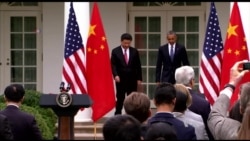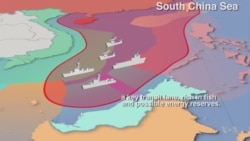The Obama administration will face a series of challenges as it pushes ahead with the U.S. rebalance to the Asia-Pacific region, seeking to further engage it without increasing tensions with China.
The White House is expected to host the leaders of Asia-Pacific nations in 2016, after President Barack Obama deepened ties while attending the annual meeting of the Association of Southeast Asian Nations and the adjoining East Asia Summit in November.
“The Asia-Pacific is absolutely critical to promoting security, prosperity and human dignity around the world,” Obama said. “That’s why I’ve devoted so much of my foreign policy to deepening America’s engagement with this region.”
In a bid to solidify the U.S. as a leader there, Obama has hosted some regional leaders at the White House and met with others during multiple trips to the region.
WATCH: South China Sea explainer
The U.S. goal is to create a peaceful and prosperous Asia-Pacific. Regional security and economic prosperity are both cornerstones of the U.S. pivot, but challenges loom, according to analysts.
TPP trade deal
One key hurdle involves the Trans-Pacific Partnership agreement, the economic centerpiece of the strategic rebalance. The massive trade deal first must be ratified by the 12 nations that are parties to it.
But the TPP faces a tough battle in Congress, which must approve it.
“If we are not seen as playing in an economic way in the region, that will end up being detrimental to U.S. interests,” said Christopher Johnson, Asia analyst with the Center for International and Strategic Studies in Washington. Congress’ failure to approve the deal will raise doubts about U.S. resolve to follow through on the rebalance, he added.
Another key challenge in 2016 will continue to be maritime disputes in the South China Sea, said Asia analyst Marc Noland of the Peterson Institute for International Economics in Washington.
“China’s territorial claims and other actions have created anxiety among many of the smaller countries in the region, so they welcome the United States' presence,” Noland said. “At the same time, they don’t want to get drawn into confrontations between the United States and China.”
Caution required
The United States will have to walk a fine line.
“The balancing act will be trying to reassure partners and allies, particularly in Southeast Asia, that the U.S. is responsive to its military alliance commitments with regard to growing Chinese activism in the region, but not make it look to the Chinese as if it’s a containment strategy to try to damage China’s interest in the region,“ Johnson said.
The U.S. has committed to helping Southeast Asian nations build up their maritime capabilities, and it has called on China to halt reclamation, new construction and militarization of disputed areas in the South China Sea.
Cybersecurity also will continue to be a source of friction between the two global powers, Johnson said.
The U.S. believes China is linked to a rise in the number of cyberespionage cases against the government and businesses. Beijing denies that.
“I think we’ll see more political pressure on the administration to move toward sanctioning Chinese beneficiaries of cyber-enabled espionage, and when that happens, the Chinese are likely to retaliate," Johnson said.
After a trip to Southeast Asia in November, Obama said the U.S. is poised to deepen ties even further, with leaders from the region set to visit the White House in 2016.













